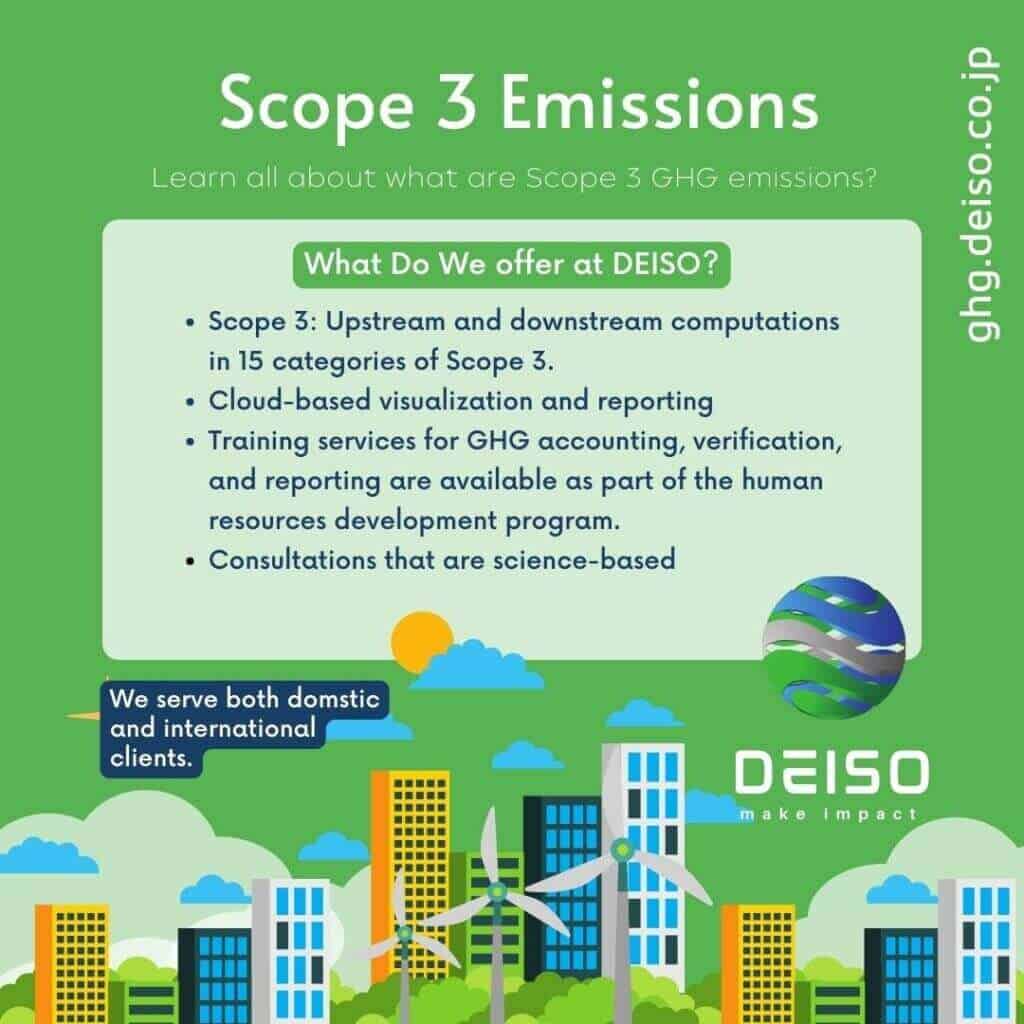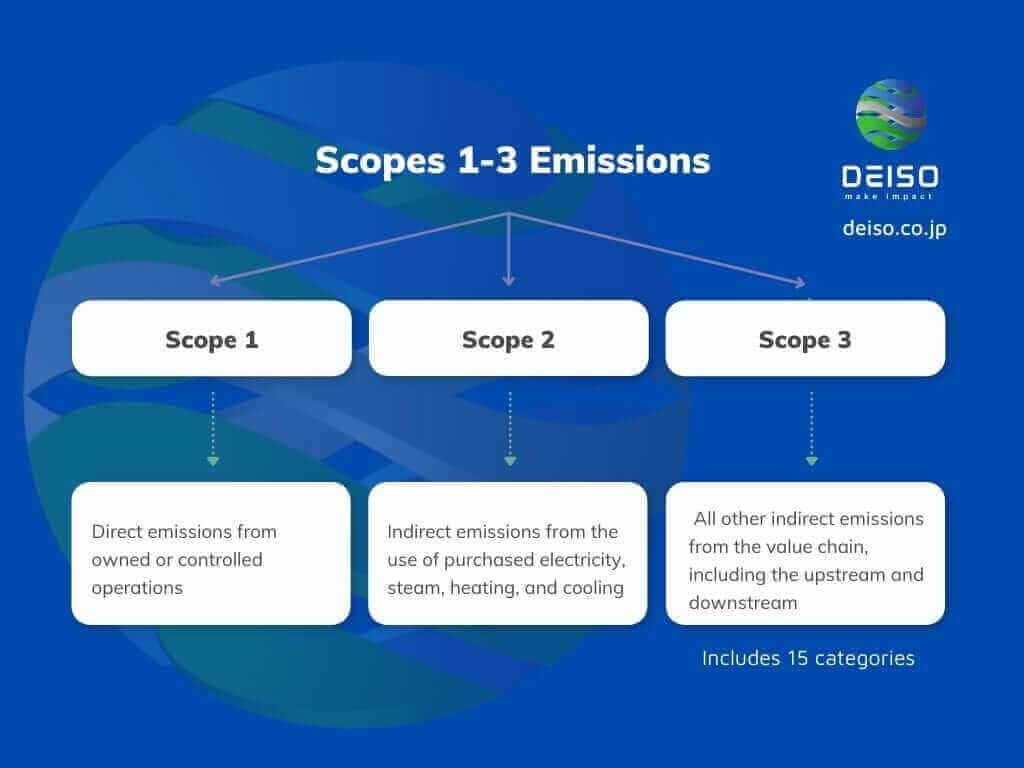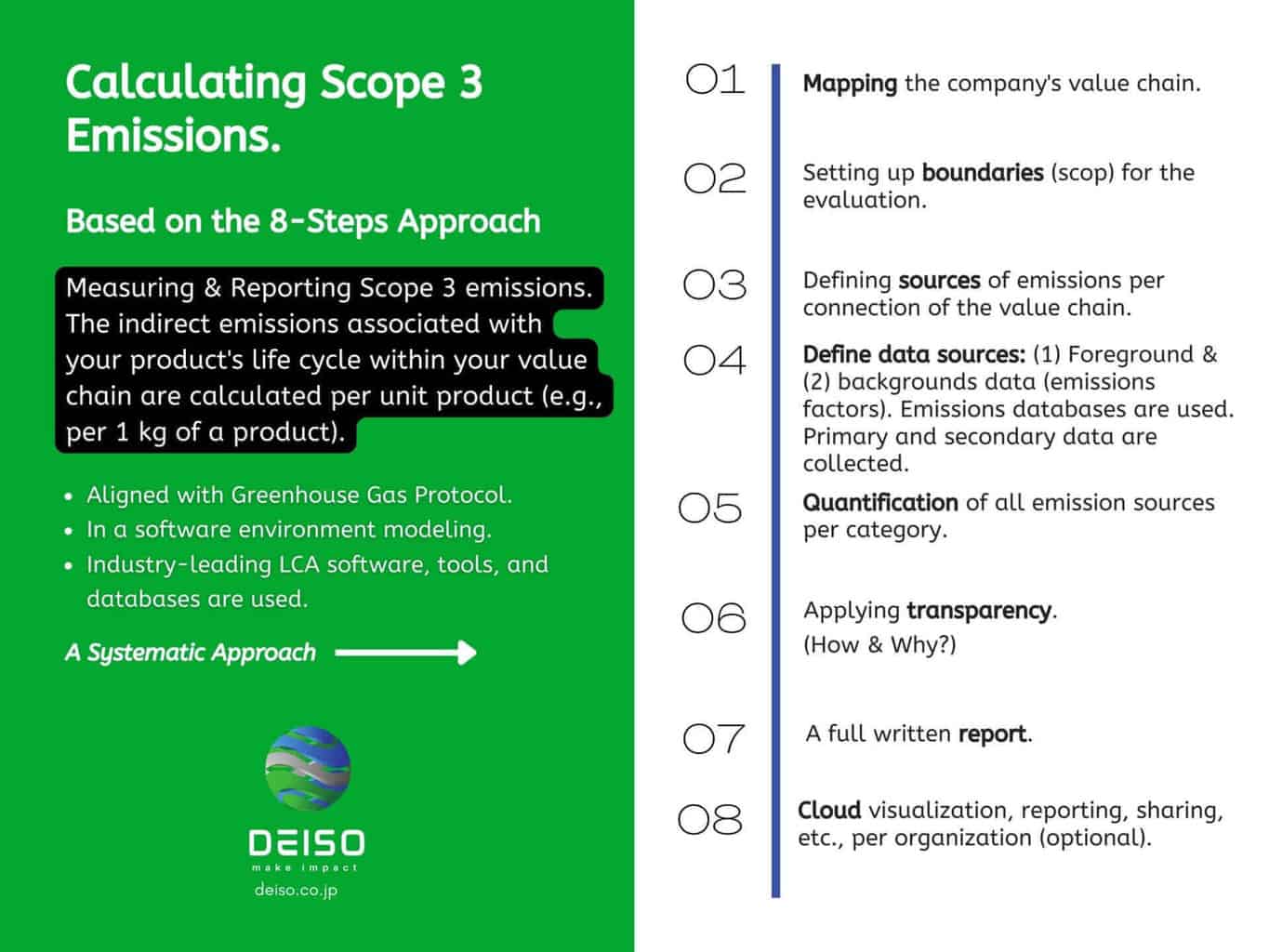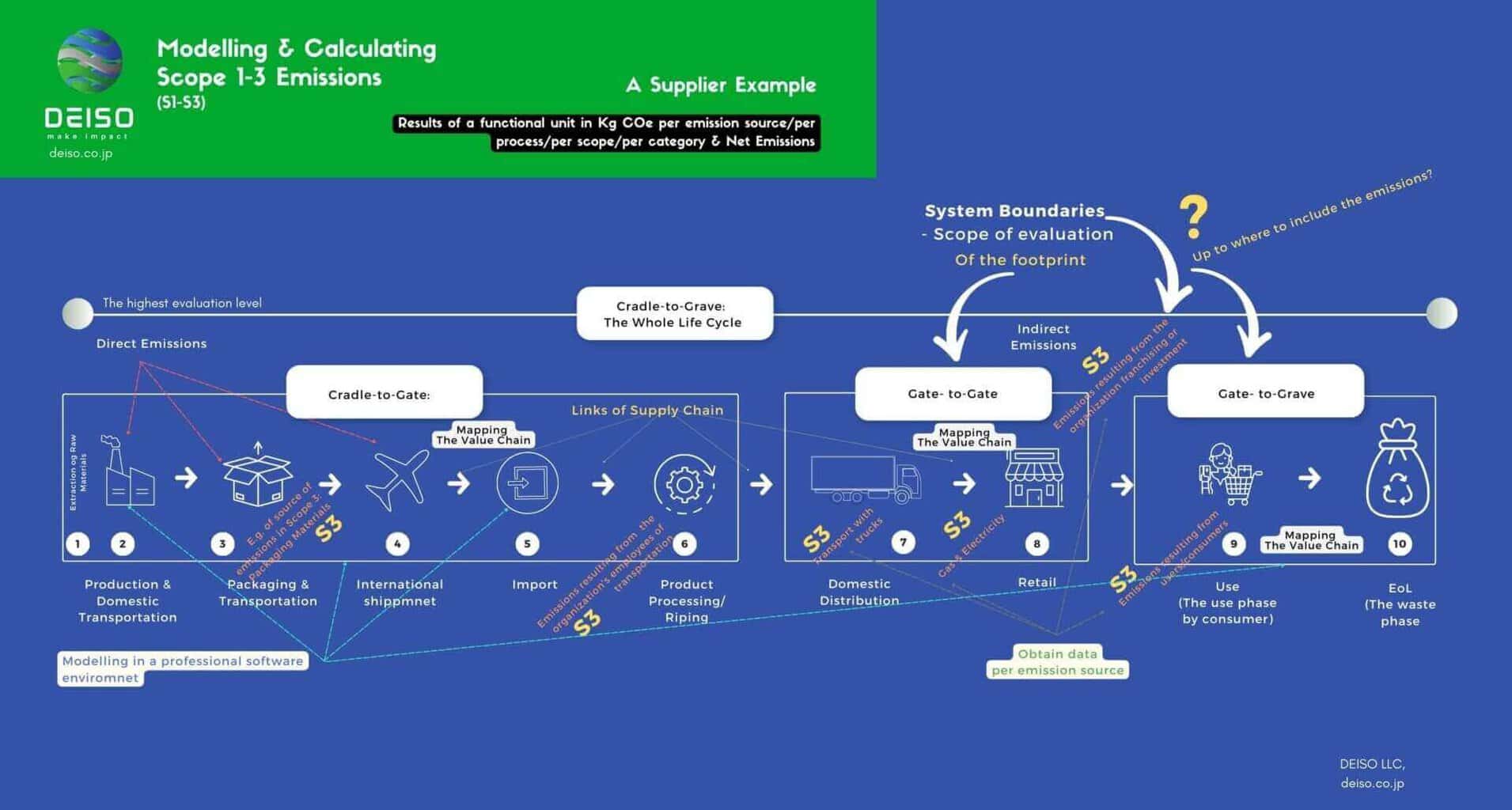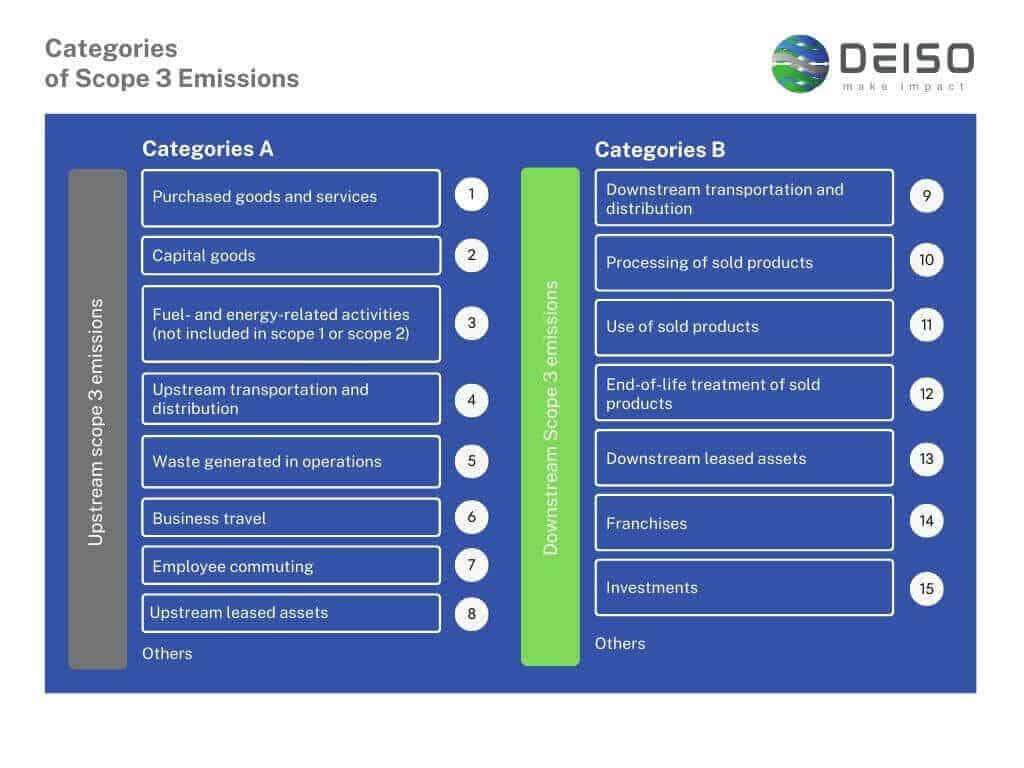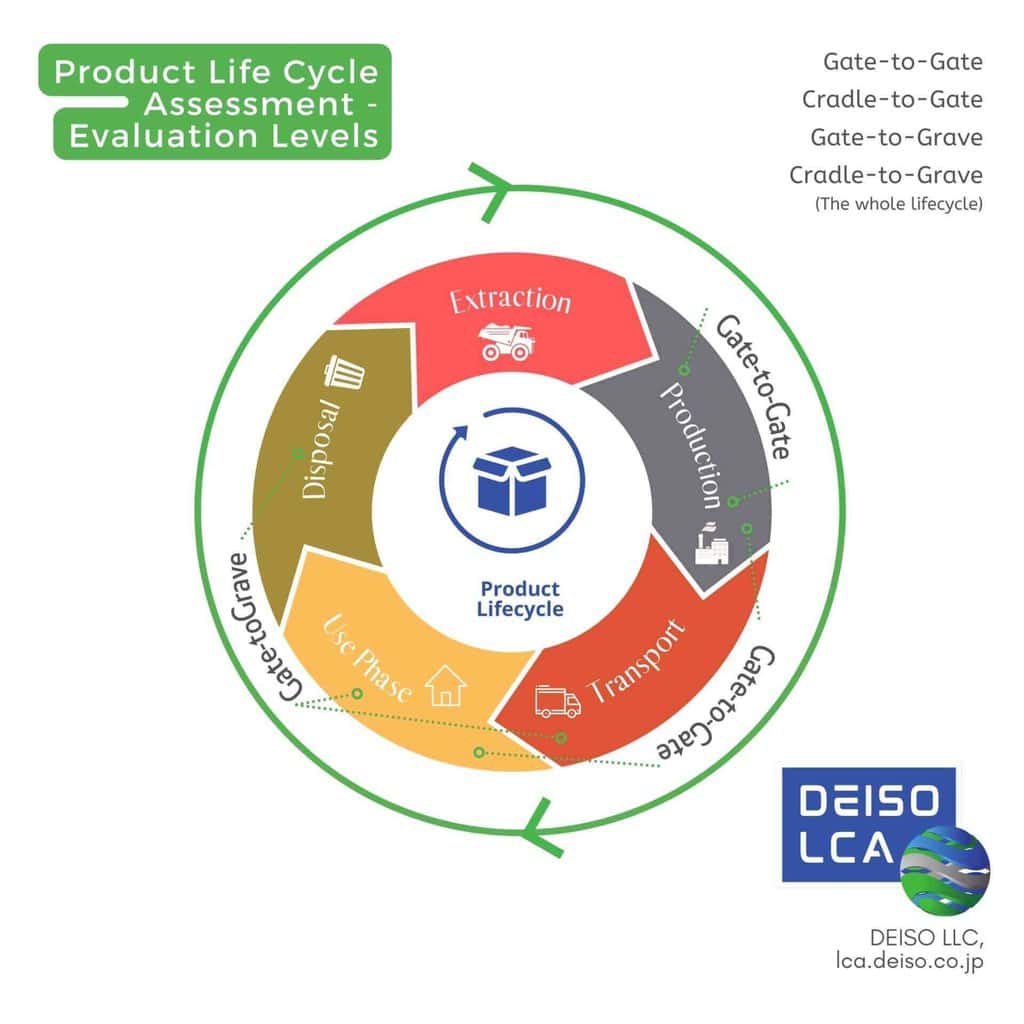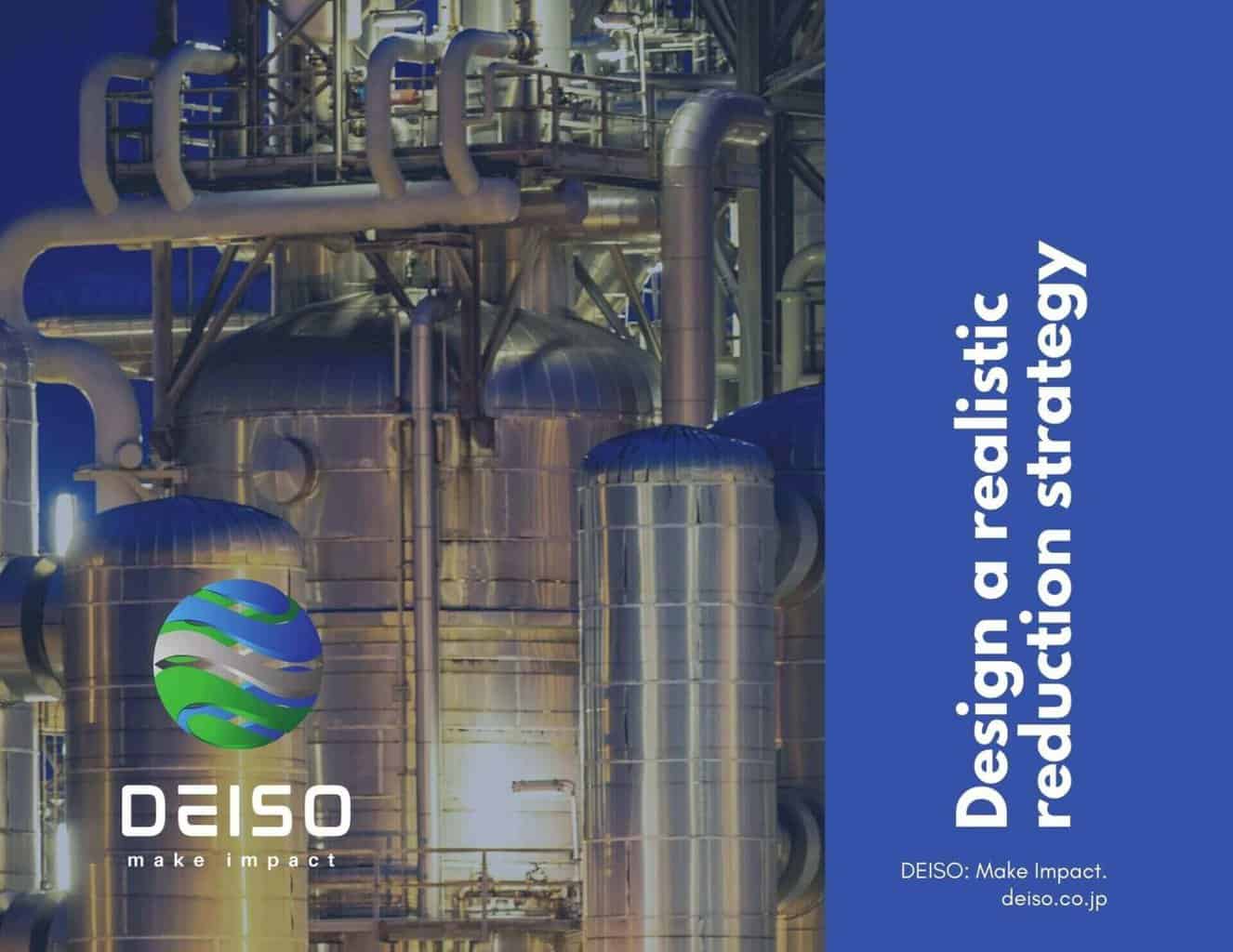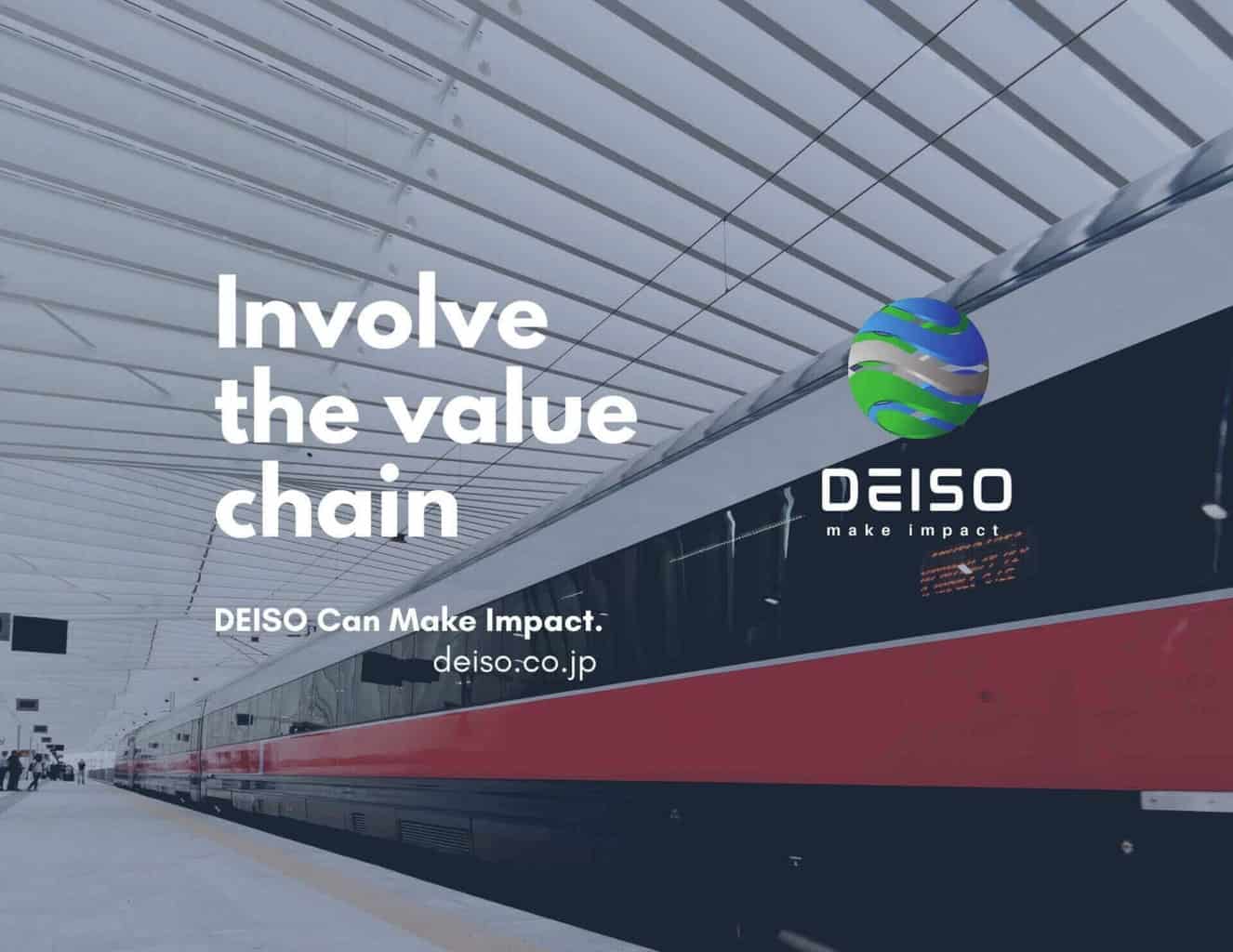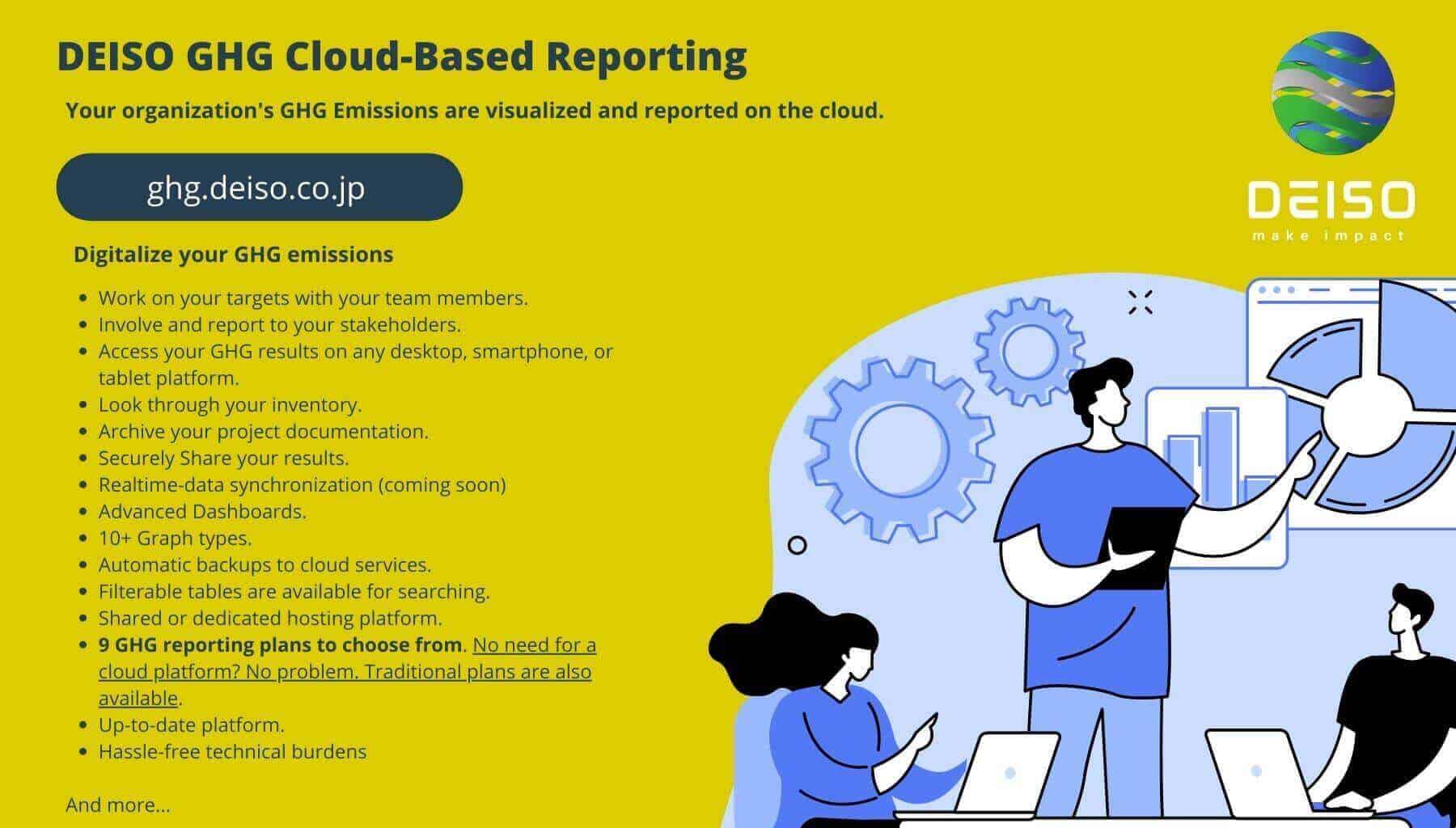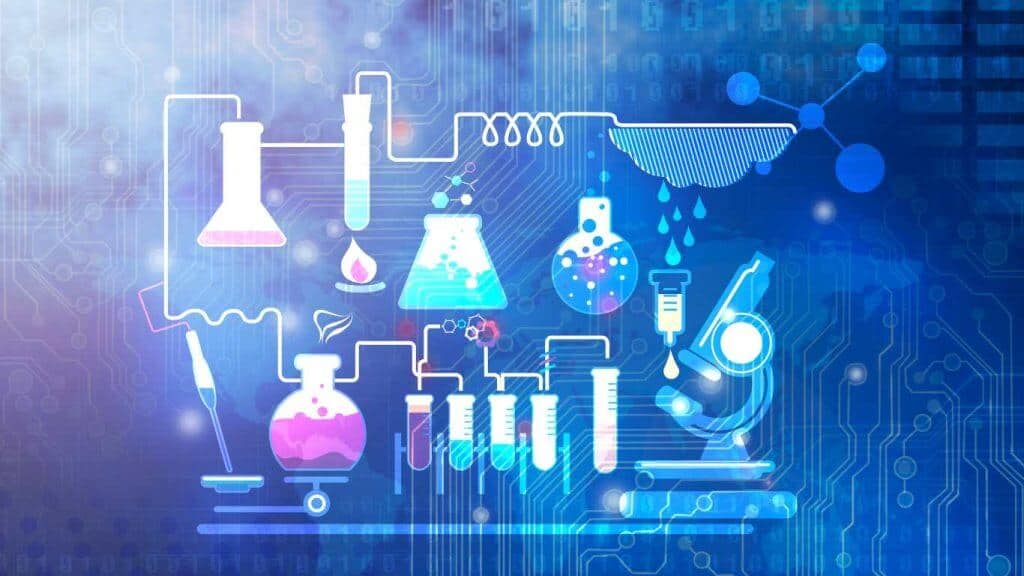Table of Contents
What Are Scope 3 Emissions, and How Can DEISO Assist Your Orgnization With Carbon Emissions of Scope 3?
Scope 3 carbon emissions
Scope 3 emissions are indirect carbon emissions from an organization’s value chain that do not relate to the generation of purchased energy. Scope 3 carbon emissions typically reside outside organizations – both upstream and downstream. The organization’s value chain is a significant contributor to Scope 3 emissions. An organization’s direct emissions, called ‘Scope 1 emissions,’ refer to the carbon produced through its actions, such as fuel combustion and vehicle use. Indirect emissions from energy purchases, such as electricity, heat, steam, or cooling, are included in Scope 2. The term also includes upstream – for example, purchasing goods and services to make products or deliver services. Also included is downstream, for example, how a customer operates a product after being taken to market.
GHG Protocol defines 15 categories applicable to Scope 3 emissions, including those that an organization manages, such as purchases, business travel, and investments. Scope 3 carbon emissions are the most complex part of an organization’s emissions due to their broad scope and how they differ depending on the organization.
Scope 3 considers other emissions generated by the organization when fossil fuels are burned in their value chain. Including upstream – e.g., goods and services purchased into an organization to manufacture goods or services. Also included is what happens downstream – for example, after a product is sold and used by customers.
The three Scopes categorize these emissions in the Greenhouse Gas Protocol (GHG).
- Scope 1: Direct emissions from a company’s sources.
- Scope 2: Indirect emissions of energy purchased to operate (electricity, heating, & cooling).
- Scope 3: All other indirect emissions from the value chain, upstream and downstream. Cover everything from purchased goods and raw materials, business travel and employee commuting, operational waste, and End-of-Life (EoL) treatment.
“CO2”: Carbon Dioxide; “CH4” Methane; “N2O: Nitrous Oxide”; “ HFCs”: Hydrofluorocarbons; “PFCs”: Perfluorocarbons ; “SF6”: Sulfur Hexafluoride; “NF3”: Nitrogen Trifluoride
“Direct emissions,” or Scope 1 emissions, result directly from an organization’s actions, such as fuel combustion and using its vehicles. Indirect emissions result from the purchase of electricity, heat, steam, or cooling from an energy provider. A Scope 3 assessment covers all indirect emissions resulting from the upstream and downstream value chain. All aspects of the organization’s operation are covered, including, e.g., purchased goods and raw materials, travel and employee commuting, capital goods, energy-related activities, use of goods, and operational waste.
Customer and supplier emissions result from the company’s products and services. Transport, office buildings, and employee travel are examples of residual emissions from a company’s operations not associated with its products and services. A company can manage Scope 3 emissions in 15 categories, e.g., goods and services purchased, business travel, and investments.
Scope 3 carbon emissions are the most complex of an organization’s emissions due to how broad they are and how they differ widely between organizations. There are three Greenhouse Gas (GHG) categories: of scopes emissions: Scope 1, Scope 2, and Scope 3 were. Scope 3 emissions are often challenging to identify and quantify, making them less likely to be included in the GHG inventories of several organizations.
Japan's Net-Zero Emissions by 2050.
As the world’s third-largest economic system and one of the most developing countries, Japan committed responsibility to acquire the deal with climate change.
Japan’s path to challenging climate change is bold and ambitious. Under the eye of the UN Climate Change Convention, Japan has committed to decreasing GHG emissions by 26% from 2013 levels by 2030. The second milestone is to promote innovation of groundbreaking technology by 2050 that enables Japan to contribute to the reduction in accumulated Atmospheric CO2 globally by “Beyond Zero.” But to achieve this goal, drastic changes will be needed in business practices, products, GHG accounting, monitoring, evaluation, and reporting.
The third and most ambitious milestone unveiled by Prime Minister Mr. Suga Yoshihide on October 26, 2020, calls for Japan to achieve zero GHG emissions by 2050. This bold pledge sets Japan on a course to become carbon neutral in 30 years. This bold pledge should help the country join the rest of the world in international efforts to become carbon neutral (meaning no more carbon dioxide is emitted than what is naturally absorbed).
To be carbon neutral by 2050, Japan has to evaluate these imperatives. Utilize current technologies while methodically prioritizing the development and implementation of critical new technologies. Even with energy conservation, electrification, decarbonization of power sources, and hydrogen fuel systems, a future without fossil fuels may be unattainable. Negative emission technologies for capturing and storing carbon dioxide will be an essential component of Japan’s strategy. To address the long-term uncertainty surrounding technology and methods for industry sectors where decarbonization is difficult, many policy solutions will need to be examined to develop environmentally-friendly sustainable growth for the carbon neutrality vision. Thus, GHG accounting that is not limited to Scopes 1-2 but Scope 3 also is critical. Scope 3 is a significant contribution to the organization’s activities and is often not considered.
Steel, chemicals, cement, pulp, and paper are the major industrial sectors. The approach to achieving this is based on three fundamental principles.
- Promote innovation and technology as change agents in addressing global warming concerns.
- Promote Green Finance to aid in developing new technologies and innovations.
- Encourage increased international cooperation for the commercialization of new green technology.
Achieving Net-Zero by 2050, and with many businesses setting more ambitious goals, several organizations in Japan are increasingly making efforts to reduce their GHG emissions and evaluate and lower their Scope 3 emissions.
Calculating Scopes 1-3 and Scope 3 emissions
Measuring & Reporting Scope 3 emissions. The indirect emissions associated with your product’s life cycle within your value chain are calculated per unit product.
- Mapping the company’s value chain.
- Setting up boundaries (scop) for the evaluation.
- Defining sources of emissions per connection of the value chain.
- Define data sources: (1) Foreground & (2) backgrounds data (emissions factors). Emissions databases are used. Primary and secondary data are collected.
- Quantification of all emission sources per category.
- Applying transparency.
- A full written report.
- Cloud visualization, reporting, sharing, etc., per organization (optional)
It was stated that direct emissions, or Scope 1 emissions, occur directly due to an organization’s actions, such as fuel combustion or using the organization’s vehicles. Indirect emissions result from the purchase of electricity, heat, or steam from an energy provider. Scope 3 assessments take indirect emissions from upstream and downstream value chains. All aspects of the organization’s operation are covered, including purchased goods and raw materials, travel and employee commuting, and operational waste.
Because of the products and services offered by the company, customer and supplier emissions are generated. Besides product and service emissions, residual emissions from a company’s operations can include emissions from transport, office buildings, and employee travel. Purchasing goods and services, traveling for business, and investing are categories under which Scope 3 emissions can be managed for a company.
Due to their broad nature and the fact that they vary widely between organizations, Carbon emissions in Scope 3 are the most complex of an organization’s emissions. Scope 3 emissions are frequently challenging to identify and quantify., making them less likely to be included in GHG inventories. The Scope 3 calculations will be discussed within the key concerns and what DEISO can offer to your company in the following sections.
We offer a GHG reporting service at DEISO that can cover all of the Scopes. We calculate Scope 3 emissions (and Scopes 1-2) using up-to-date emission factor databases and the GHG standard protocol with the apocopate company’s activities and production data. Experts perform the calculations, which are then visualized in the cloud-based on various subscription plans. A company may select the one that best suits its needs, goals, or emission reduction targets.
Determining the categories of focus
The first thing to note is that the process varies depending on the location and size of the company and the sector in which it operates. Each industry has its own business environment regarding its environmental impact and emissions. E.g., the financial industry differs from a manufacturer or a retailer. Even companies in the same industry can vary depending on the products they sell.
Thus, establishing which of the 15 categories is substantial to an organization’s activity is the first step in estimating Scope 3 emissions. For example, a grocery store may concentrate on the products and services it purchases. Domestic and international transportation activity may interest a significant financial firm.
One of the essential considerations in determining which sectors should be priorities for the company is that the process varies depending on its location and size and whether or not it operates in a particular industry. Each sector has its own business environment that includes the environmental impact from emissions so that things can change depending on location.
The most critical factor to clarify is that technology differs depending on the location and size of the employer and the industry in which it operates. Each zone has its own business context regarding its environmental impact and emissions.
For example, a financial services company may differ from a manufacturing company or business. Even businesses within the same zone may vary, depending on the goods they provide.
The first step in calculating a company’s Scope 3 emissions is determining which of the 15 classes relate to its business. For example, a grocery retailer might account for additional costs associated with purchased items and offerings. Waste created in operations may be relevant for a significant supplier. The waste that might be identified as the essential trigger is those on which the company should concentrate its efforts.
Work with a GHG data
Businesses can attempt to calculate their own Scope 3 emissions; however, as this process is typically more complex than calculating Scope 1 or 2, it is recommended that businesses work with GHG and environmental companies instead. Working with a consultant specializing in energy or environmental performance can make sense. In general, environmental impact assessment and GHG account comprise intensive details. It requires a significant amount of data about Scopes 1-3 for the impacts of climate change.
The Scope 3 categories
Scope 3 emissions can be broken down into two major categories of 15 subcategories:
- Upstream emissions – emissions from the production of the company’s products, including the use of raw materials and energy
- Downstream emissions – emissions from the company’s products and services, including the use of energy, water, and other resources
Upstream
- Purchased goods and services
- Capital goods
- Fuel and energy-related activities not included in Scopes 1 – 2
- Upstream transportation and distribution
- Waste generated in operations
- Business travel
- Employee commuting
- Upstream leased assets
Downstream
- Downstream transportation and distribution
- Processing of sold products
- Use of sold products
- End-of-life treatment of sold products
- Downstream leased assets
- Franchises
- Investments
(Source: The Greenhouse Gas Protocol)
Considering the whole lifecycle with Life Cycle Assessment (LCA)
Organizations that provide products and services may want to conduct a full Life Cycle Assessment (LCA) to increase the accuracy of their Scope 3 emissions analysis. It is worthwhile to perform an in-depth cradle-to-grave or cradle-to-cradle analysis. It is also a viable tool to calculate carbon emissions at the product level from material extraction to product use to disposal with the possibility of recycling. At DESIO, we are also fluent in LCA. We offer several individuals and specific LCA services (10+ services). For more information, please visit https://dei.so/life-cycle-assessment-lca. We also provide an all-in-one LCA service to businesses and academic institutions, DESIO LCA One. For more information on DEISO LCA One, please visit https://dei.so/deiso-lca-one.
Collaborate with a data consultant on carbon reduction or GHG emissions.
Even though an organization may try to calculate its own Scope 3 carbon emissions, it is often more complex than calculating Scope 1 or 2 emissions. Therefore, working with an energy and environmental performance consultant may be more appropriate.
Challenges in managing and calculating Scope 3 emissions.
One of the most significant obstacles in controlling Scope 3 emissions is the availability and quality of an organization’s data and the technical knowledge required to handle it. This is what we do at DEISO. Companies were rejected from the science-based targeting initiative because their submitted data was substandard. For some organizations, the measures taken by consumers also have a significant impact on Scope emissions 3. For example, a technology retailer which sells a smartphone to a customer is then responsible for the energy used to charge that laptop and the emissions resulting from its disposal at the end of its life.
Gathering and handling the required data
A GHG emissions expert should set up the data and its information and accuracy while obtaining and processing the needed data. DESIO will use 1-year data to model emissions and determine our client’s carbon footprint regarding their spending. Scope 3 emissions can be determined using both primary data unique to the activity within an enterprise’s value chain and secondary data. The datasets must be precise for the company to meet its Net-Zero and technology-based aims. When an expert collaborates with a partner organization to compute it, experts will examine these facts and figures to model emissions and quantify their carbon footprint regarding the organization’s activities.
The partner GHG business company, such as DEISO, may also develop a document that models the commercial enterprise and its Scope 3 emissions against the fabric classifications. Using the science-based objectives technique, the company may utilize these results to determine its Net-Zero journey and set Scope 3 discount targets. One of the most critical and challenging scenarios when dealing with Scope three emissions is the availability and quality of a company’s data and the technical expertise required to control them. DESIO manages our clients’ technical information to compute the GHG emissions. DEISO delivers a comprehensive analysis that models the company’s Scope 3 emissions against the Scope 3 categories or the categories of focus of those 15 categories. There are two reports offered: The first is a brief overview of Scope 3 or Scopes 1-3 emissions, including the 15 categories of Scope 3. The second is a scientifically based detailed report that introduces the organization’s activities, operations, projects, technical aspects, and data. Emission factors, data quality, calculation methodology, tools or software used to calculate GHG emissions, system boundaries, the scope of the evaluation, explanation of the evaluation and its results, reports, and recommendations for action plans.
Using the science-based review, the company may utilize these findings to guide its Net-Zero approach and establish Scope 3 reduction objectives. Managing Scope 3 emissions is difficult. Using the science-based objectives technique, the corporation may utilize these data to guide its Net-Zero journey and set Scope 3 reduction targets. One of the most significant obstacles in controlling Scope 3 emissions is the availability and quality of an organization’s data and the technical knowledge required to handle it. DESIO works with our clients’ technical data to calculate their GHG emissions, report them, and establish a reduction strategy.
Designing a realistic reduction strategy for GHG emissions
Once an organization has determined its Scope 3 baseline, it may apply a few reduction approaches to its focused categories. Depending on the evaluation scope, those may be unique. For example, while procuring products and services, the employer may communicate with its suppliers and collaborate to see what they can do to contribute to its Scope 3 emissions. A firm’s progress toward its goals should be monitored every year. DEISO assists our clients in meeting their objectives by computing and reporting their Scope 3, Scopes 1-2, or Scopes 1-3 GHG emissions.
Hotspot analyses, parameter assessment, scenario analysis and development, process evaluation, reduction potentials, and in-depth analytical evaluation of our client’s activities and projects. Several DEISO GHG Reporting plans incorporate such services. Find out more at https://dei.so/topic/greenhouse-gas-reporting-subscription-plans.
Reducing or mitigating carbon Scope 3 emissions
Once again, this depends significantly on the business, its size, location, and the services it provides. When attempting to reduce or mitigate Scope 3 emissions, a company should create a class-specific reduction strategy. Purchased products and services, for example, may need the implementation of a provider engagement program to assist them in reducing their carbon footprint. ISO 20400, a widely accepted sustainable standard, can help with this. At DEISO, we partner with our customers and collaborate to develop a category-specific mitigation plan or a whole strategy.
Different categories need distinct recognition. When looking for transportation, value chain, or supply chain. An organization should consider the global changes. Such changes are likely to interchange the GHG impacts and benefits because of global crises and pandemics, e.g., the Covid-19 pandemic and unanticipated international shifts.
Engaging the value chain
A value chain is a series of operations carried out by a company in a particular industry to provide valued goods (i.e., an item and service) to the end client. The value chain notion is based on the organizational process perspective, which views a manufacturing (or service) corporation as a system made of subsystems, each with inputs, transformation processes, and outputs.
The value chain is a critical aspect of any business regarding Scope 3. It is essential to understand the inner workings of a company. Companies can identify ways to improve efficiency and create value for customers by understanding how the value chain works. It is the sequence of activities a business performs to deliver a product or service to its customers. The value chain begins with customer discovery, where a company identifies potential customers and tries to understand their needs. This is followed by product development, where the company creates a product or service that meets the needs of those customers. The company then executes a marketing plan to reach and sell to the target market. Finally, it creates and delivers the product or service and involves various activities such as employment activities, investment, purchases, etc.
The value chain is essential because it can help a business identify where it can create the most value for its customers. For example, a company might find that it can make the most value for its customers by developing a new product rather than simply improving an existing product. The value chain can also help a business determine which activities are most important to its success and need to be improved or eliminated.
The chain of value is also critical because it can help a business understand the flow of money through its business. For example, a business may discover that it makes much money on product sales but loses money on marketing efforts. This information can help the company better allocate its resources concerning GHG emissions.
There are many components to the chain of value, and each one is important for a business to understand. By understanding and optimizing each step in the chain, a company can create more value for its customers and improve its bottom line.
One challenge for many companies is doubling down on their efforts for efficiency. One of the most efficient ways to do this is by stimulating the value chain. A few examples of good practices encompass
- Reducing inventory.
- Reducing the use of physical resources.
- Reducing the number of suppliers.
- Analyzing delivery systems and improving the speed of delivery.
- The domino effect is a great way to improve the efficiency of the value chain.
- Digitalization of the services. E.g., developing software as a Service (SaaS) or Product-as-a-Service (PaaS). At DESIO, we also help with these strategies through our circular economy services. Find out more at https://dei.so/topic/circular_economy.
Speaking your targets.
- As soon as you are dedicated to your GHG plans and targets, incentivize your value chain to serve your efforts.
- Engaging the delivery chain with dealer forums – businesses are taking advantage of virtual occasions’ convenience to interact with suppliers.
- You aid your cost chain in goal placing understanding and revel in. Despite the blessings of Scope 3 reporting, locating the proper solution can include challenges. However, the first step is to carry out a quick screening of your company’s activities and determine the Scope 3 categories to focus on.
- Gathering data from external businesses may be challenging and time-ingesting. Defining a clean strategy is how DEISO simplifies the processes and saves time.
- To correctly acquire qualitative Scope three records without burdening stakeholders, businesses should work with technical procedures specific to accumulating, measuring, and handling such data. Companies ought to adopt approaches and equipment that pragmatically force carbon ahead of overall performance reporting to use vast quantities of record points.
Reduction and mitigation action
An agency must make sure it has decreased its emissions, consisting of Scope 3 lot as it may earlier than it considers carbon offsetting. This is crucial if the enterprise has set a technology-based target that does not guide offsets. The complexity is that the statistics are frequently drawn from many resources. It becomes a systems integration assignment to convey it collectively. There are numerous standard approaches or customized ones accessible that assist with this.
Another considerable barrier is how a corporation’s success in decreasing Scope 3 emissions depends on its providers and partners, which may not be as ambitious in their carbon-slicing endeavors. For example, an organization may also have set a Net-Zero target of 2030. Still, one of its enormous suppliers might have developed a much less bold pathway for 2050. For some corporations, consumers’ movements affect Scope 3 emissions. For example, a technology retailer which sells a PC to a customer is then chargeable for the power used to rate that pc and the emissions attributable to its disposure at the quilt of its lifestyle. Both elements are complex for an organization to manipulate, and this is in which collaboration and engagement are essential. Many agencies are put off going public with their intentions because they could then be held to account for things they understand as past their management and criticized if they fail. We can assist you in addressing your greenhouse gas reduction or mitigation plans, issues, and goals. You can reach us at https://dei.so/contact to discuss your requirements.
– Environmental benefits: Global warming is as soon once more at the forefront of urgent dialogs. However, it has spread past environmental activists and into the sector. Producers, oil and gasoline suppliers, steel, chemicals, cement industries, and even commercial aircraft speak out about the risks to their businesses if the world fails to take the correct steps to combat international warming. However, while companies can at the moment reap the benefits of advancing their green credentials, they cannot afford to do this without making sure that they are enhancing their environmental credentials in the long-term.
The green technology sector embraces the notion that the best way to succeed is to discover sustainable and renewable ways to do business. As consumers demand companies concerned about the environmental impacts of their business, it is becoming increasingly crucial for companies to offer solutions that will allow them to follow the growing trend. To establish an environmentally sound industry and achieve these, the process begins with GHG accounting and then developing realistic action plans.
– Reputational benefits: There may be additionally a reputational advantage. A corporation with a bold target, which it discloses publicly, will probably appeal to extra sustainability-aware clients to shop for its products or services. Arguably, assume an enterprise does now not flow towards more sustainable enterprise strategies. Consumers will turn away from the products and offerings it presents because they are considered environmentally distasteful.
Organizations are under extra pressure from buyers, customers, and regulators to be transparent with sustainability and environmental and social governance (ESG) facts. Collecting and reporting Scope three records brings challenges. However, it also brings significant opportunities to affect actual trade and leave an enduring legacy.
Benefits for funding and investment: In the economic zone, ESG finances are often seen to perform higher as divestment away from fossil fuels keeps pace. People increasingly consider sustainability in phrases of exposure and what it means for their investment. Corporations increasingly seek to degree and report the ‘cost’ in their carbon emissions and traditional income metrics.
Benefits for compliance: Getting beforehand on compliance and any other advantage in dealing with Scope 3 emissions puts a business enterprise in advance by applying for certifications and assembly standards. Many requirements and certification schemes have viewed disclosure on Scope three emissions as a “first-class to have.” But many now harden that requirement and stipulate how its miles met.
Benefits of attracting talent:
The same is going for employees. Again, by addressing Scopes 1-3 emissions, an enterprise will likely attract high-quality expertise. Humans, specifically those under 30, increasingly want to paintings for sustainable and responsible organizations.
What are the future influences for Scope 3 emissions?
Consumers are learning about sustainability problems and are stressed sustainable merchandise that is anecdotally promoting 3-four times extra than conventional products. Clients assume the brands they buy from to have prominent sustainability practices. And this is having a knock-on effect on governance, with many standards and certifications now consisting of Scope 3 emissions reporting as a requirement rather than a “first-class to have,” specially to achieve Net-Zero plans by 2050 as in the case of Japan.
Carbon offsetting
Carbon offsetting is one way an enterprise may additionally wish to help reach its reduction targets. At DESIO, we assist our clients with how offsetting should remember closer to decarbonization desires. It is far extensively seemed that to be influential. A few companies can also choose carbon offsetting as a substitute, which entails investment in emissions reduction within a business enterprise’s supply chain. At DESIO, we provide services for carbon offsetting except for our GHG accounting services. You may locate greater at https://dei.so/topic/carbon-offsetting.
An Industrial viewpoint
Grounding industrial organizations are paying greater interest to Scope 1, 2, and 3 emissions like chemicals, steel, cement, metals, and materials industries, as well construction and manufacturing industries by putting an ambitious, measurable target that demonstrates how your organization addresses the primary sources of value chain GHG emissions. But, knowing you need to be doing something and handing over it are exceptional. While starting on or comparing your Scope 3 emissions reporting, here are things to remember. DEISO can desire your enterprise with a collective “work together” approach centered on your agency’s goals.
What are the value and benefits of DESIO GHG Reporting?
DEISO’s GHG, LCA, and sustainability experts are your one way to compute your Scope 1-3 GHG emissions. The online platform offers data visualization, sharing, and export. We provide cloud-based services to ensure all users have access no matter where they are.
The GHG platform is a cloud-based hosting portal where every company has its GHG profile. The GHG platform offers a comprehensive set of services to help companies reduce their carbon footprint. The cloud-based hosting portal is hassle-free and accessible from anywhere at any time with an internet connection. It provides company profiles that allow users to visualize and search within the inventory online, which can be filtered by table or filter criteria setting, allowing you to see what data has been reported back so far without going through old reports yourself! Plus, there here is always access to documentation-and, even downloadable versions. Find more at https://dei.so/topic/greenhouse-gas-reporting-subscription-plans.
The benefits of the cloud platform are numerous. You can have an entire image in a visualized dashboard, share your project with team members and stakeholders for easy collaboration on GHG calculations submission online; access data from desktop tablets and smartphones using cross-platform compatible environments which allow you to compare different sources (GHGs) across projects or departments – all this while submitting production activities securely through a secure platform.
There are nine GHG reporting plans to choose from. Is there no need for a cloud platform? No worries. There are also traditional plans available with no cloud hosting/platform. Find more at https://dei.so/topic/greenhouse-gas-reporting-subscription-plans.
- At DEISO, we paintings to your company to Compute its GHG emissions (Scope 1-3).
- We offer our clients a complete and apparent written report.
- We provided visualized and sharable outcomes in the cloud.
- We assist our clients in identifying the current or pressing 15 categories of Scope.
- We conduct an entire evaluation to pick out the hotspots and increase alternative activities and method productions or business plans from technical perspectives.
- We help our customers professionally document their GHG offline with nicely-prepared reports or online thru our GHG cloud services.
- We assist your company in expanding a roadmap for GHG reduction.
- We help your corporation to achieve its reduction potential and goals.
How much does it cost: What are the market prices?
The prices rely upon the complexity of the organization’s activities, projects, scopes to be calculated (Scopes 1-3, or 1-2, or Scope 3 only), the project’s content, data, and others. Scope 3 computing market price cost roughly will price among 2 million Japanese yen to 5 million Japanese yen, depending on the organization and the complexity of its activities. In the GHG services market, 1 to 3 months are needed to compute the emissions. Reduction schemes and investments will add more significance to this initial price and timescale. However, from a pricing viewpoint, at DEISO, we offer services that are lower than these prices and ensure high-quality standards, consisting of other scopes, Scopes 1-3. But again, the costs depend upon several elements associated with the organization, its activity, and the dimensions and complexity of its projects and activities. At DEISO, we offer various subscription plans. The emissions are computed and visualized in the cloud or submitted traditionally via printed reports or digitally by email, which would be a cheaper option. There are 9 GHG Reporting plans for Scopes 1-3. Also, we offer custom-designed plans. The charge of every plan is quotation-based. After discussions with our client organization activities and needs, we provide quotations through email or through a remote or face-to-face meeting. Discover more at https://dei.so/topic/greenhouse-gas-reporting-subscription-plans. Or reach us at https://dei.so/contact to schedule an appointment.
At DESIO, we provide deeper analysis along with hotspot analysis, uncertainty analysis while emission factors estimation whenever they are lacking, sensitivity analysis to measure how the emissions are sensitive against a particular process, activity, or parameter, and scenario improvement, in which we design various scenarios seeking for potentials for emissions reductions from Scope 3 or other scopes most straightforward or Scopes 1-3.
Discover more
Visit https://dei.so/topic/greenhouse-gas-reporting-subscription-plans to learn more about DESIO GHG Reporting services. If you have any questions or would like to schedule a meeting, please email us at [email protected].
If you enjoyed this post, join our free newsletter for more valuable content! Subscribe now for informative articles, service updates, downloadable guides, and more. Click here!
Contact Us
What would you like to discuss with us about your projects, organizations, GHG emissions, needs, business, or partnership? Please get in touch with us, and request a schedule a remote meeting.
You can also email us at [email protected] if you have any questions.

